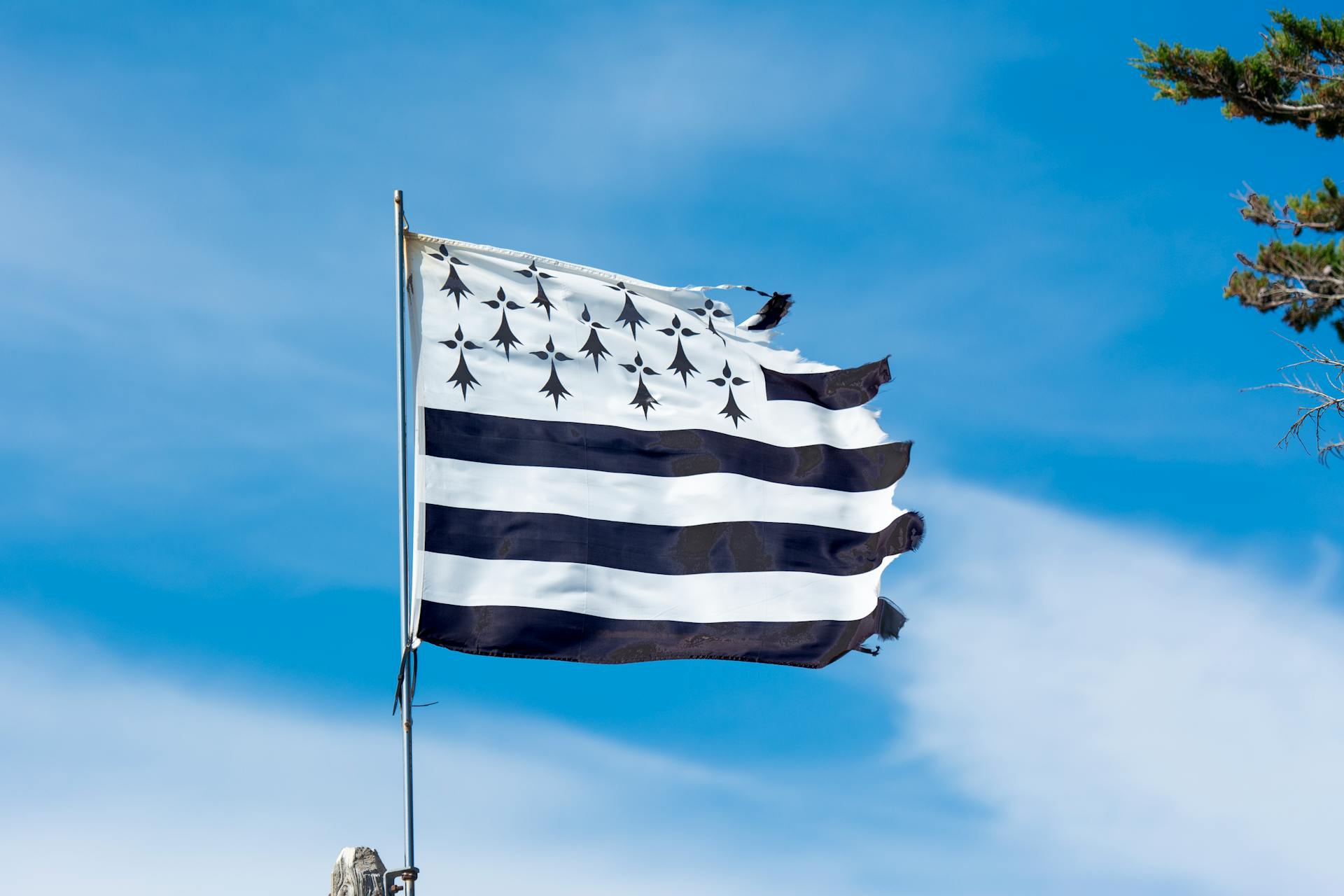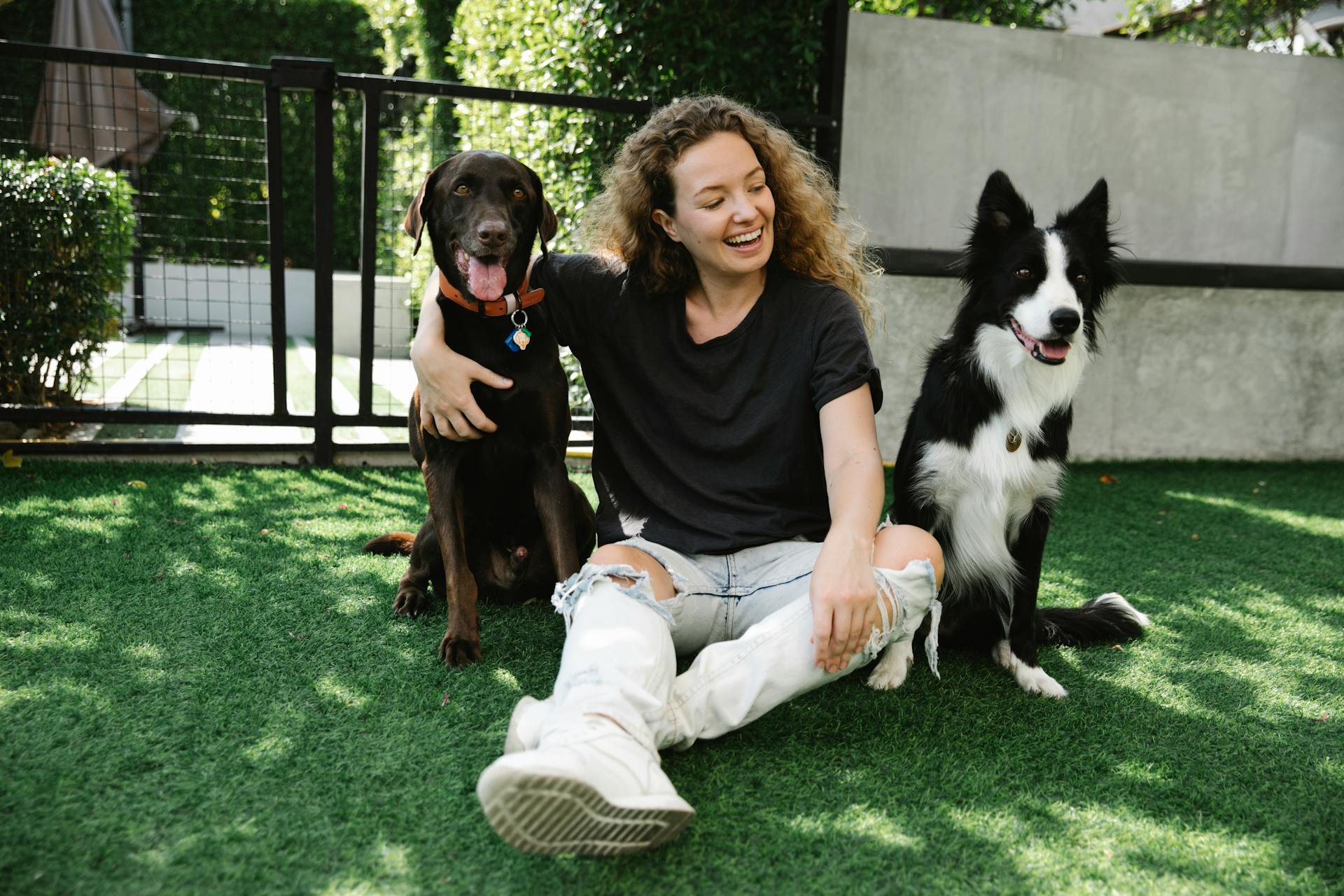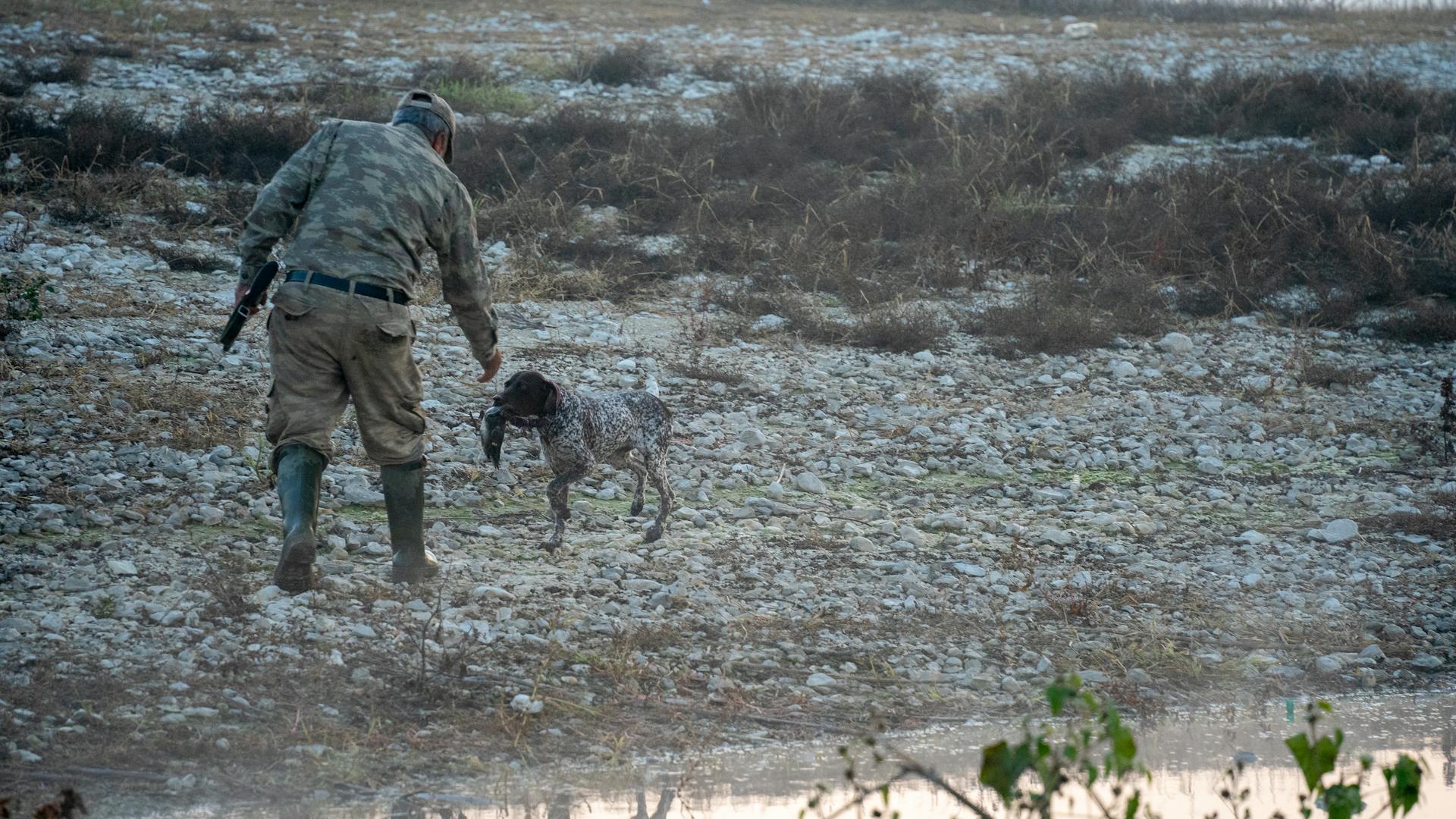
American gun dogs are bred to assist hunters in the field, and their keen instincts make them an essential companion for any hunt.
Their strong prey drive allows them to track and flush out game with ease.
From the Labrador Retriever's exceptional nose to the German Shorthaired Pointer's agility, each breed has its unique strengths that make them valuable assets on a hunt.
Whether you're after waterfowl or upland game, a well-trained gun dog can make all the difference in your success.
A fresh viewpoint: How to Train a German Shorthaired Pointer to Hunt
Types of American Gun Dogs
American gun dogs are incredibly diverse, with different breeds excelling in various hunting scenarios. There are three primary types of gun dogs: retrievers, pointing breeds, and water dogs.
Retrievers are bred to retrieve game, and they're often used for waterfowl hunting. They're expected to remain calm and quiet until sent to retrieve, and they'll watch and follow the handler's gun as they shoot. A well-trained retriever can recall the location of multiple downed birds and retrieve them one by one.
Pointing breeds, on the other hand, are bred to locate game and hold a "point" until the hunter is ready to shoot. They're often used for upland bird hunting and have a strong instinct to follow the scent of game. English Pointers and English Setters are two examples of pointing breeds.
Water dogs, including Spaniels and Standard Poodles, are bred to navigate water and retrieve game from the water. They have a strong instinct to swim and often have webbed paws to help them do so.
Here are some examples of popular American gun dog breeds:
These breeds are just a few examples of the many different types of American gun dogs. Each breed has its unique characteristics and strengths, and the right breed for you will depend on your hunting style and needs.
Characteristics and Behavior
American gun dogs are highly intelligent and sociable animals, making them perfectly suited to being family pets as well as working dogs. They thrive on interaction and stimulation, and can become withdrawn or uncooperative if not given enough physical and mental activity.
Gundogs have a strong instinct to work and please their owners, which can make them extremely obedient if properly trained and encouraged. However, this can also lead to them becoming unruly if not given enough exercise or mental stimulation, so regular walks and training are essential.
Their hard-wired retrieving behavior can lead them to carry personal items around the house, so it's essential to channel this energy into fun and productive activities. Gundogs can excel in activities such as agility, working trials, heelwork to music, obedience, flyball, rally, and scent work, which provide both physical and mental stimulation.
In the field, gundogs are expected to be self-contained while waiting around, but ready to leap into action at a moment's notice. This self-control is a key characteristic of a well-trained gundog, and is essential for their role as a working companion.
Gundogs are not the sensitive type, and are hardy dogs both physically and mentally, making them well-suited to a variety of living situations. They can thrive in kennels or in family homes, as long as they receive regular exercise, training, and attention.
Consider reading: Why Are Labrador Retrievers so Popular
Exercise
American gun dogs need a lot of physical exercise – ideally at least two hours every day, no matter the weather.
Gundogs love variety, so exercise should include on-lead walking in towns and along footpaths, plus plenty of free-running and exploration in safe areas.
They're country dogs at heart, so the more trees, bushes, and brambles they can sniff out, the better.
If they spot a body of water, you can be almost certain they'll try to have a paddle, so remember to carry a dog towel on walks near lakes, ponds, and even puddles!
Treat your dog to their own paddling pool in the garden if they enjoy water, but make sure it's the hard plastic type.
Exercise should include a variety of free-running, sniffing, and exploring in different terrains to keep their interest.
Gundogs can truly excel at exercise if it falls within their skill set and a good trainer can channel these skills appropriately.
Consider reading: Bernese Mountain Dog Exercise
They're very driven to work and will always thrive with a job to do or an outlet for their natural behaviors.
For example, retrieval games, scent work, or even fun games of hide and seek are great ways to exercise your gundog.
Find a good reward-based training class to help your dog learn and have fun at the same time.
Gundogs love playing games that channel their working abilities, like playing gentle retrieve games on walks or in the house.
They also love playing with their human family and other friendly dogs, but they're also quite content amusing themselves.
A unique perspective: Bull Terrier Fun Facts
Hunting and Safety
Hunting and Safety is crucial for both you and your furry companion. Here are some essential tips to keep in mind.
Train your dog to be comfortable around gunfire to avoid any stress or anxiety. This will ensure a fun day out for both of you.
To make your dog easily visible in the field, put them in a brightly colored vest. This is a simple yet effective way to prevent any accidents.
Make sure your dog is microchipped and wearing ID tags, so they can be identified if they get lost. Vaccinations and flea and tick prevention are also a must to keep them healthy.
Here are some key things to pack for your dog:
- Enough food
- Enough water
- First aid supplies
By following these simple safety tips, you and your hunting dog will be ready for a fun and safe day out.
Types of Hunting
When venturing into the world of hunting, it's essential to know the types of hunting dogs that can aid you in the field. There are many different types of hunting dogs, each bred for special skills, to hunt certain types of prey, or to expertly navigate specific terrains.
Some of the most popular hunting dogs in the U.S. are bird dogs, hounds, curs, and terriers. Bird dogs, in particular, are great companions for hunters.
Bird dogs, also known as gun dogs, hunt alongside humans. They come in three subcategories: pointers, flushers, and retrievers.
Pointers are expert at finding game and will "point" with their muzzle toward potential game. Flushers, on the other hand, provoke the birds to fly, allowing hunters to target them.
Retrievers are the ultimate fetchers, bringing the prey back to the hunter.
For more insights, see: Hunt Terrier
Hunting Safety Tips
Hunting with dogs can be a fun and rewarding experience, but it's essential to prioritize your furry companion's safety. Train your dog to be comfortable around gunfire to avoid any potential stress or harm.
To make your dog easily visible in the field, put them in a brightly colored vest. This simple step can save a lot of time and trouble if your dog ever gets lost. I've seen it happen to friends, and it's not a pleasant experience.
Make sure your dog is microchipped and wearing ID tags at all times. This way, if your dog ever gets separated from you, they can be easily identified and returned.
Vaccinations and flea and tick prevention are also crucial for your dog's health and safety. Have your dog vaccinated and up to date on these essential treatments to avoid any potential health risks.
To keep your dog happy and energized throughout the hunt, pack enough food, water, and first aid supplies. Don't forget to check the expiration dates of your supplies and replace them as needed.
Here are some essential safety tips to keep in mind:
- Train your dog to be comfortable around gunfire.
- Put your dog in a brightly colored vest.
- Make sure your dog is microchipped and wearing ID tags.
- Have your dog vaccinated and up to date on flea and tick prevention.
- Pack enough food, water, and first aid supplies for your dog.
Breed-Specific Information
The American Gun Dog is a versatile breed that excels in various roles, including hunting and companionship. They are known for their high energy levels and strong work ethic.
One of the key characteristics of the American Gun Dog is their strong prey drive, which makes them excellent hunting companions. This breed is also highly trainable and thrives on mental and physical stimulation.
American Gun Dogs are generally a medium to large breed, with males weighing between 50-70 pounds and standing between 20-24 inches tall. They have a short, smooth coat that requires minimal grooming.
Curious to learn more? Check out: Dog Names for Strong Dogs
Setters
Setters are bred to hunt out difficult-to-find game and can freeze in place to indicate the position of the game.
By eight months, these breeds can hunt with serious intent, and control and focus are by-products of well-trained setters.
Setters are a premium breed for hunting due to their ability to freeze in place and indicate the position of the game.
They require plenty of exercise in all weathers and stimulation to keep them happy and healthy.
Check this out: Game Bred American Pit Bull Terrier
Chesapeake Bay Retriever
The Chesapeake Bay Retriever is a versatile hunting companion with high energy. They're bred to be the perfect duck hunter for the Chesapeake Bay's frigid waters.
These bird dogs have a thick, oily double coat to protect them from the cold. This coat is essential for their survival in harsh winter conditions.
Their webbed paws also help them swim, making them great swimmers. This is just one of the many reasons why they're well-suited for waterfowl hunting.
They're often used in hunting upland birds as well, but waterfowl hunting is their primary purpose. This is where their retrieving skills come in handy.
Retrievers, including the Chesapeake Bay Retriever, are trained to remain calm and quiet until sent to retrieve. They watch and follow the handler's gun as they shoot, marking and remembering each bird that is downed.
Redbone Coonhound
The Redbone Coonhound is a breed that's steeped in history, tracing its origin back to the early days of the U.S. They were bred to be skilled hunters, with raccoons as their primary prey.
Their ability to navigate all kinds of terrain is impressive, making them a valuable companion for hunting partners.
Boykin Spaniel
The Boykin Spaniel is the state dog of South Carolina. They're particularly skilled at hunting in wetlands.
Their webbed paws make them natural swimmers, and they love the water. Bred to hunt waterfowl, these dogs have a strong instinct to chase after birds.
They're designed to excel in their hunting role, with a focus on hunting waterfowl.
Plott Hound
Plott Hounds love to spend as much time outdoors as possible. They were historically bred for hunting big game, which means they need regular exercise to be happy.
Plott Hounds were originally used for tracking bears and boars. This tells us that they're confident and determined dogs.
Regular exercise is essential for Plott Hounds. If they don't get enough physical activity, they might not be happy.
Take a look at this: Images of Bluetick Coonhounds
Foxhound
The American Foxhound is a scent hound that's fast and agile, led by its nose. This breed was historically popular among hunters in the southern U.S.
The American Foxhound is one of the rarest dog breeds.
Mountain Cur
The Mountain Cur is a popular breed among outdoor enthusiasts. They were favored by American pioneers for their tenacious nature and ability to cover a lot of ground on the hunt.
These dogs have a strong instinct to "tree" their prey, which means they can track and corner their quarry with ease.
Their ruggedness and intelligence make them well-suited for life in the wilderness.
Is a Breed Right for You?
Before getting a dog, it's essential to consider whether a specific breed is right for you.
Some breeds are prone to overeating, which can lead to weight issues. This is especially true for breeds that love food.
A gundog breed may not be the best fit for a household with young children, as some of these breeds can be energetic and boisterous.
Regular exercise is crucial for maintaining a gundog's physical and mental health.
Some breeds require a lot of grooming to prevent matting and tangling of their fur.
A Weimaraner's love of food can lead to weight gain if not monitored.
Here's an interesting read: Gundog Com
General Information
American gun dogs are a versatile group of breeds that excel in various roles, from hunting to companionship. They're known for their intelligence, athleticism, and strong instinct to please their handlers.
One of the defining characteristics of American gun dogs is their strong prey drive, which makes them naturally inclined to pursue game. This instinct is honed through generations of selective breeding.
These dogs are often used for hunting waterfowl, upland game birds, and small mammals, and are prized for their ability to work in a variety of environments and conditions.
History
The history of gundogs is a fascinating one. The term gundog refers to any breed or type of dog that traditionally has 'worked alongside the gun'.
In the past, people had to hunt for food due to a nomadic lifestyle. This led to the creation of breeds that could adapt well to this sport.
Diverse landscapes and a huge variety of animals available to hunt required different types of dogs. For example, hunting in wetlands requires waterproof coats and a lot of stamina to stay in the water for a long time.

Hunting deer requires dogs that are fast and have a lot of stamina. Patience and obedience were also crucial characteristics in building this working relationship.
Dogs that hunted foxes and took part in game shooting were often kept in kennels on large estates in the United Kingdom. Owners would look after their well-bred dogs with caution to ensure they bred with other high-caliber dogs.
To avoid health concerns, owners would breed their dogs with careful consideration. This ensured that the next generation of gundogs would be even stronger and have more physical stability than their predecessors.
By taking care of their dogs' health and wellbeing, owners could produce the best hunting outcome.
Broaden your view: English Cocker Field Bred
Term Origin
The term "General Information" has a broad scope, and its origin can be traced back to the way we categorize and organize knowledge.
The concept of categorizing knowledge dates back to ancient civilizations, where scribes and scholars organized texts and ideas into various categories for easier reference.

The term "General Information" likely originated from the need to provide a broad overview of a subject, covering its fundamental aspects and key concepts.
This type of information is often presented in a way that is accessible to a wide audience, making it a valuable resource for people with varying levels of knowledge and expertise.
Frequently Asked Questions
What is the easiest gun dog to train?
Labrador Retrievers are known for being highly intelligent and eager to please, making them one of the easiest breeds to train. Their loyalty and trainability make them a popular choice for hunters and families alike.
What are Hpr breeds?
HPR breeds are versatile dogs bred for three main roles: hunting, pointing, and retrieving. They are typically large, athletic dogs with a distinctive hunting pattern.
What is the best all-round gun dog?
The Labrador Retriever is a top choice for an all-round gun dog, known for its athleticism, intelligence, and eagerness to please. Originally from Newfoundland, this breed excels in various hunting roles.
Featured Images: pexels.com


